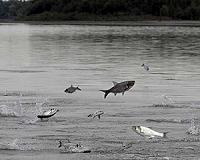| . |  |
. |
Washington DC (SPX) May 02, 2011 Box jellyfish may seem like rather simple creatures, but in fact their visual system is anything but. They've got no fewer than 24 eyes of four different kinds. Now, researchers reporting online in Current Biology, a Cell Press publication, have evidence revealing that four of those eyes always peer up out of the water, regardless of the way the rest of the animal is oriented. What's more, it appears that those eyes allow the jellies to navigate their way around the mangrove swamps in which they live. "It is a surprise that a jellyfish-an animal normally considered to be lacking both brain and advanced behavior-is able to perform visually guided navigation, which is not a trivial behavioral task," said Anders Garm of the University of Copenhagen. "This shows that the behavioral abilities of simple animals, like jellyfish, may be underestimated." In fact, scientists have known for more than a century that box jellyfish had a unique array of eyes. It was known that they could rely on vision to respond to light, avoid obstacles, and control their rate of swimming. But box jellyfish generally live in shallow waters with plenty of obstacles. The species Garm's team studied, Tripedalia cystophora, lives between the prop roots in Caribbean mangrove swamps, where they stay close to the surface to catch and eat copepods that gather in high densities in light shafts formed by openings in the mangrove canopy. They are never found out in the open, where they might risk starvation. That means they must stay within a rather restricted area, less than two meters wide. And it now appears that they have eyes that help them do this. The researchers examined the function of one of two types of "upper lens eyes," already known to form images, to work out just what those eyes can see and how well. It turns out that those four eyes cover precisely the visual field needed to see through the water's surface up into the world above. The researchers calculated that the jellies should be able to detect the mangrove canopy from a distance of at least eight meters. Behavioral experiments of the jellies in the field supported those conclusions, revealing that the jellyfish can use those eyes to navigate based on their view of the canopy alone. When the canopy was obscured from view, they could no longer get around. "We have shown that the box jellyfish can use vision to navigate in their habitat, and we now want to understand how their simple nervous system supports such advanced behaviors," Garm said. They also want to know if other box jellyfish species do the same thing in the places where they live. Overall, this new understanding of the upper lens eyes points to a more general strategy for managing complex sensory tasks without a big brain. "Instead of having a single pair of general-purpose eyes like most other animals, box jellyfish have several different types of eyes used for special purposes," Garm said. "This means that each individual eye type is dedicated to support only a limited number of behaviors. The eyes can then be built to collect precisely the information needed, minimizing the need for further processing in a big brain. The automatic orientation of the upper lens eyes to constantly look through the water surface is a clear example of this."
Share This Article With Planet Earth
Related Links - Water News - Science, Technology and Politics
 New biomass data reveals fish stocks more stable than believed
New biomass data reveals fish stocks more stable than believedWashington DC (SPX) May 02, 2011 Fish and marine species are among the most threatened wildlife on earth, due partly to over exploitation by fishing fleets. Yet there are differences in assessing trends in worldwide fishing stocks which, researchers writing in Conservation Biology argue, stem from inappropriate use of time trends in catches. "Estimates of fishery status based on catches suggest that around 30% of fisherie ... read more |
|
| The content herein, unless otherwise known to be public domain, are Copyright 1995-2010 - SpaceDaily. AFP and UPI Wire Stories are copyright Agence France-Presse and United Press International. ESA Portal Reports are copyright European Space Agency. All NASA sourced material is public domain. Additional copyrights may apply in whole or part to other bona fide parties. Advertising does not imply endorsement,agreement or approval of any opinions, statements or information provided by SpaceDaily on any Web page published or hosted by SpaceDaily. Privacy Statement |